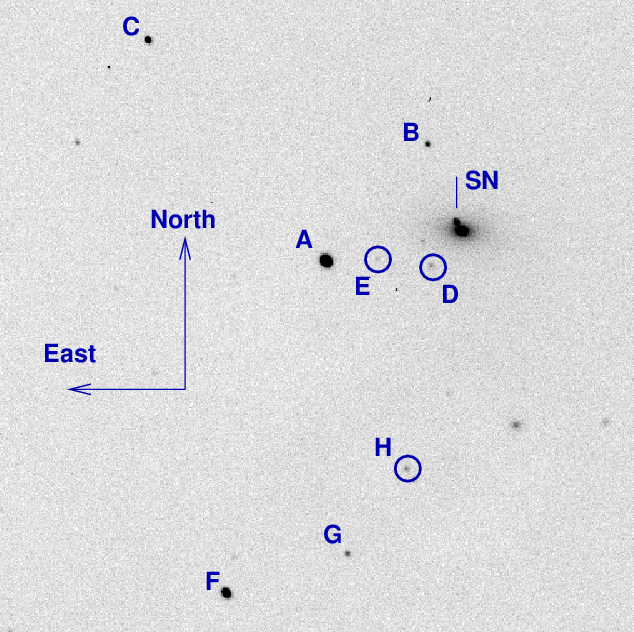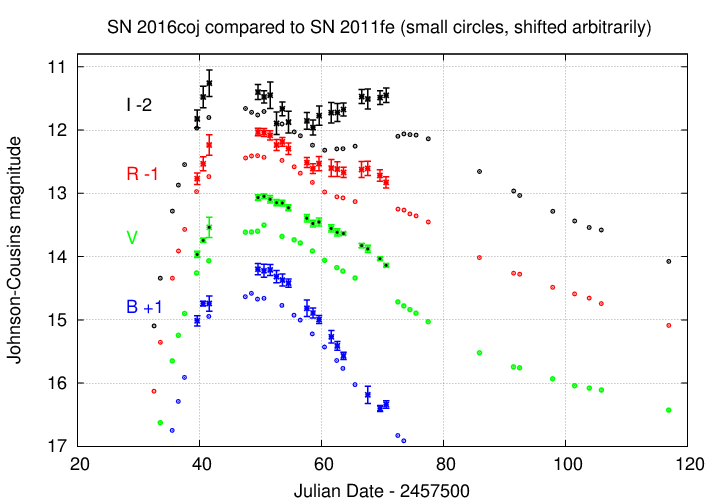
On the night of Jun 30/Jul 01, 2016, I observed SN 2016coj in NGC4125.
The main setup was:
Notes from the night
SN 2016coj is a Type Ia supernova in the relatively nearby galaxy NGC4125. It was discovered by the KAIT group some time before maximum light:
NGC 4125 RA = 12:08:05.7 Dec = +65:10:30 (J2000)

The AAVSO sequence team kindly provided photometry for stars near this object. You can see their full photometric sequence on their website. Below, I show only the members of that sequence which fall into my very small field of view -- taken from AAVSO sequence X16266F.
letter B sigB V sigV R sigR I sigI ------------------------------------------------------------------------ B 15.198 0.086 14.133 0.052 13.627 0.116 13.155 0.156 C 13.317 0.093 12.673 0.058 12.316 0.121 11.980 0.161 -------------------------------------------------------------------------
I've been investigating the cause for changes in the values of 30-second dark frames, which I noticed a few nights ago. On this night, I took six series of 30-second dark frames: one set before flats, several sets after flats as I waited for the sky to darken, then two at the end of the run: one with lights off, one with lights on. The CCD-TEMP keyword in the FITS header indicated a constant temperature of about -14 degrees Celsius.

The final two sets are identical, so the idea that stray light was causing changes is out. Note that the initial set of darks is basically the same as the final set, and the highest values appear right after the flats. The most likely cause is some residual or excess charge created by the saturated images taken before the good flats: I can see the average values of individual dark frames decreasing steadily with time after the flats.
Moral of the story: try to avoid saturating the chip during the twilight-sky flat procedures, and do NOT take dark frames right after the flats; take them before flats, if possible, or late in the run.
I took sets of 15-20 images in each filter, guiding in BVRI I used longer guide exposure times (12 sec) in B and I. I discarded any trailed images. I checked the focus after RVB on NGC 4125, but it looked fine in I-band as it was.
As explained in the notes to Jun 14, 2016, I used the "rotsub" technique to remove the galaxy's light at the position of the SN.
On this night, I used "method 2", which means performing "rotsub" on each individual image, then combining all the resulting images in a passband to make a "master rotsub" image.
Using aperture photometry with a radius of 4 pixels (radius of 5.5 arcsec) I measured the instrumental magnitudes of a number of reference stars and the target. Following the procedures outlined by Kent Honeycutt's article on inhomogeneous ensemble photometry, I used all stars available in each image to define a reference frame, and measured each star against this frame. I used the interim reference magnitudes above plus color terms which I am currently revising -- so please treat these results as preliminary to convert the ensemble instrumental magnitudes to the standard Johnson-Cousins BVRI scale.
Note that in the graph below, I combine data calibrated with UCAC4 photometry (first few weeks) with recent data calibrated with AAVSO photometry. That's inconsistent, and I'll re-compute all magnitudes later.
filter mag mag_uncert Julian Date
SN B = 15.337 +/- 0.059 (ens 0.046 zp 0.037) 2457570.61016
SN V = 14.138 +/- 0.023 (ens 0.023 zp 0.004) 2457570.59886
SN R = 13.828 +/- 0.089 (ens 0.020 zp 0.086) 2457570.59066
SN I = 13.451 +/- 0.113 (ens 0.027 zp 0.109) 2457570.62176
Below is a preliminary light curve, based on RIT Observatory measurements. I also show measurements of SN 2011fe in M101, an ordinary type Ia supernova, shifted arbitrarily.

Last modified 07/01/2016 by MWR.